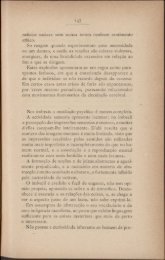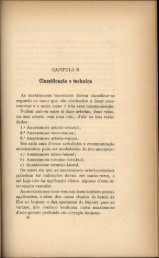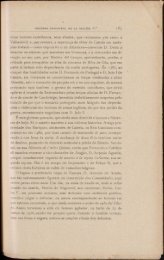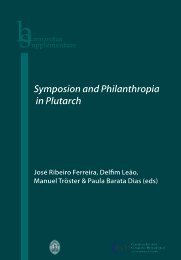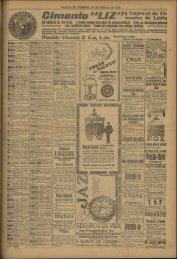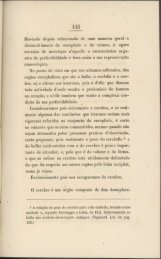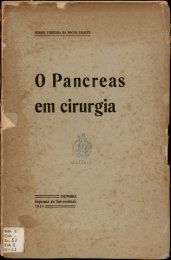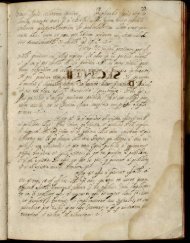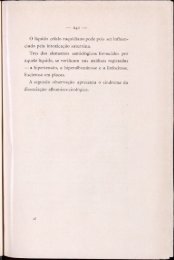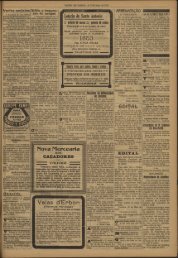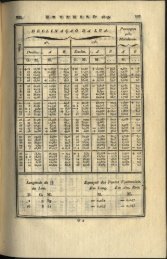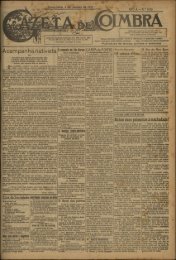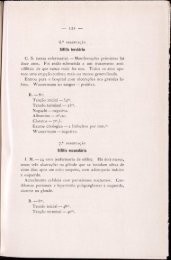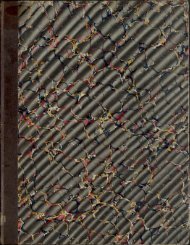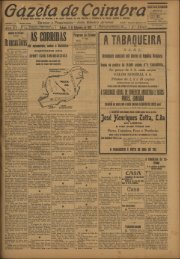- Page 1 and 2: The Lyric Metres of Euripidean Dram
- Page 3 and 4: Author Frederico Lourenço Title Th
- Page 5 and 6: 6.1.3. ‘xDx’ (erasmonidean) 73
- Page 7 and 8: Preface O triunfo da ἱστορί
- Page 9 and 10: O triunfo da ἱστορία sobre
- Page 11 and 12: SymbolS Metrical Symbols O triunfo
- Page 13 and 14: O triunfo da ἱστορία sobre
- Page 15 and 16: Part I Euripides’ use of lyric me
- Page 17 and 18: Part I - Euripides’ use of lyric
- Page 19 and 20: Part I - Euripides’ use of lyric
- Page 21 and 22: Part I - Euripides’ use of lyric
- Page 23: Part I - Euripides’ use of lyric
- Page 27 and 28: Part I - Euripides’ use of lyric
- Page 29 and 30: Part I - Euripides’ use of lyric
- Page 31 and 32: Part I - Euripides’ use of lyric
- Page 33 and 34: Part I - Euripides’ use of lyric
- Page 35 and 36: Part I - Euripides’ use of lyric
- Page 37 and 38: Part I - Euripides’ use of lyric
- Page 39 and 40: Part I - Euripides’ use of lyric
- Page 41 and 42: Part I - Euripides’ use of lyric
- Page 43 and 44: Part I - Euripides’ use of lyric
- Page 45 and 46: Part I - Euripides’ use of lyric
- Page 47 and 48: Part I - Euripides’ use of lyric
- Page 49 and 50: 4.Dochmiac Dochmiac Dochmiac rhythm
- Page 51 and 52: 100 ἐc θεούc, τύχαι cο
- Page 53 and 54: Πρίαμοc ὅθι ποτὲ β
- Page 55 and 56: Dochmiac she does not tell us where
- Page 57 and 58: Dochmiac (3) ∪ — ∪∪ ∪ —
- Page 59 and 60: (21) — ∪∪ ∪∪ — ∪∪:
- Page 61 and 62: 5. Dactylic Dactylic In Greek drama
- Page 63 and 64: Dactylic — ∪ ∪ — ∪ ∪
- Page 65 and 66: Dactylic Or. 1395 (followed by chan
- Page 67 and 68: Part I - Euripides’ use of lyric
- Page 69 and 70: Part I - Euripides’ use of lyric
- Page 71 and 72: Part I - Euripides’ use of lyric
- Page 73 and 74: Part I - Euripides’ use of lyric
- Page 75 and 76:
7.Dactylo-epitrite Dactylo-epitrite
- Page 77 and 78:
Dactylo-epitrite — — ∪ ∪
- Page 79 and 80:
Dactylo-epitrite Ion 769, Hel. 686,
- Page 81 and 82:
8. Ionic Ionic Ionic is hardly ever
- Page 83 and 84:
8.4. Lengths with ‘iambic’ pref
- Page 85 and 86:
Part I - Euripides’ use of lyric
- Page 87 and 88:
Part I - Euripides’ use of lyric
- Page 89 and 90:
Part I - Euripides’ use of lyric
- Page 91 and 92:
Part I - Euripides’ use of lyric
- Page 93 and 94:
Part I - Euripides’ use of lyric
- Page 95 and 96:
Part I - Euripides’ use of lyric
- Page 97 and 98:
Part I - Euripides’ use of lyric
- Page 99 and 100:
Part I - Euripides’ use of lyric
- Page 101 and 102:
Part I - Euripides’ use of lyric
- Page 103 and 104:
Part I - Euripides’ use of lyric
- Page 105 and 106:
Part I - Euripides’ use of lyric
- Page 107 and 108:
Part I - Euripides’ use of lyric
- Page 109 and 110:
Part I - Euripides’ use of lyric
- Page 111 and 112:
Part I - Euripides’ use of lyric
- Page 113 and 114:
Part I - Euripides’ use of lyric
- Page 115 and 116:
Part I - Euripides’ use of lyric
- Page 117 and 118:
Part I - Euripides’ use of lyric
- Page 119 and 120:
Part I - Euripides’ use of lyric
- Page 121 and 122:
Part I - Euripides’ use of lyric
- Page 123 and 124:
Introductory Note Cyclops In the in
- Page 125 and 126:
Part II - Scansions 134 68 — —
- Page 127 and 128:
Part II - Scansions Cycl. 608-623
- Page 129 and 130:
Part II - Scansions 138 107 — —
- Page 131 and 132:
Part II - Scansions Strophe 2 ~ 252
- Page 133 and 134:
Part II - Scansions Strophe 215 ~ 4
- Page 135 and 136:
Part II - Scansions κομμόc (Al
- Page 137 and 138:
Part II - Scansions 146 1002 —
- Page 139 and 140:
Part II - Scansions 153 — — ∪
- Page 141 and 142:
Part II - Scansions Second Stasimon
- Page 143 and 144:
Part II - Scansions Fourth Stasimon
- Page 145 and 146:
Part II - Scansions 154 1285 ∪
- Page 147 and 148:
Part II - Scansions First Stasimon
- Page 149 and 150:
Part II - Scansions 158 764 — —
- Page 151 and 152:
Hippolytus Hippolytus Similarly to
- Page 153 and 154:
Hippolytus 164 — — — ∪ ∪
- Page 155 and 156:
Hippolytus 538 ∪ — ∪ ∪ —
- Page 157 and 158:
Hippolytus 743 ∪ ∪ — ∪ —
- Page 159 and 160:
Hippolytus 851 ∪ — — ∪ —
- Page 161 and 162:
Hippolytus 1272 ∪ — — ∪ —
- Page 163 and 164:
Part II - Scansions 174 129 — ∪
- Page 165 and 166:
Part II - Scansions 176 475 — —
- Page 167 and 168:
Part II - Scansions ~ antistrophe 7
- Page 169 and 170:
Part II - Scansions 180 865 — ∪
- Page 171 and 172:
Part II - Scansions Χο. 1204 ∪
- Page 173 and 174:
Part II - Scansions 184 165 — ∪
- Page 175 and 176:
Part II - Scansions 186 459 — —
- Page 177 and 178:
Part II - Scansions Εκ. 694 —
- Page 179 and 180:
Part II - Scansions Hec. 1024-1034
- Page 181 and 182:
Parodos (Su. 42-86) Supplices Hecub
- Page 183 and 184:
First Stasimon (Su. 365-380) Suppli
- Page 185 and 186:
Supplices 782 ∪ — ∪ — —
- Page 187 and 188:
Supplices ~ antistrophe 963 — ∪
- Page 189 and 190:
Κομμόc (Su. 1123-1163) Supplic
- Page 191 and 192:
Monody (El. 112-166) Electra Suppli
- Page 193 and 194:
Parodos (El. 167-212) Electra Strop
- Page 195 and 196:
451 ∪ ∪ ∪ — ∪ ∪ — —
- Page 197 and 198:
Electra 722 ∪ ∪ — ∪ ∪ —
- Page 199 and 200:
κομμόc (El. 1177-1232) Electra
- Page 201 and 202:
Electra 1228 — ∪ — ∪ —
- Page 203 and 204:
Part II - Scansions 216 134 — ∪
- Page 205 and 206:
Part II - Scansions 218 400 — ∪
- Page 207 and 208:
Part II - Scansions 220 665 — —
- Page 209 and 210:
Part II - Scansions 222 765 ∪ —
- Page 211 and 212:
Part II - Scansions Αμ. 891 ∪
- Page 213 and 214:
Part II - Scansions Αμ. 1047 ∪
- Page 215 and 216:
Part II - Scansions Θη. 1185 —
- Page 217 and 218:
Part II - Scansions Parodos (Tr. 15
- Page 219 and 220:
Part II - Scansions 232 206 — ∪
- Page 221 and 222:
Part II - Scansions Τα. 264 —
- Page 223 and 224:
Part II - Scansions 236 330 ∪ —
- Page 225 and 226:
Part II - Scansions Duet (Tr. 577-6
- Page 227 and 228:
Part II - Scansions ~ antistrophe 1
- Page 229 and 230:
Part II - Scansions 242 1087 —
- Page 231 and 232:
Part II - Scansions Χο. 1298 ∪
- Page 233 and 234:
Parodos (IT 123-235) Iphigenia in T
- Page 235 and 236:
Iphigenia in Tauris 197 † ∪ ∪
- Page 237 and 238:
Iphigenia in Tauris 429 — — ∪
- Page 239 and 240:
Iphigenia in Tauris 851 — — ∪
- Page 241 and 242:
Iphigenia in Tauris 1118 — —
- Page 243 and 244:
Iphigenia in Tauris 1242 — —
- Page 245 and 246:
Part II - Scansions 260 140 — —
- Page 247 and 248:
Part II - Scansions 262 208 † —
- Page 249 and 250:
Part II - Scansions 264 489 ∪ ∪
- Page 251 and 252:
Part II - Scansions Χο. 754 ∪
- Page 253 and 254:
Part II - Scansions 268 862 ∪ ∪
- Page 255 and 256:
Part II - Scansions ~ antistrophe 1
- Page 257 and 258:
Part II - Scansions Κρ. 1445 ∪
- Page 259 and 260:
Part II - Scansions 1494 ∪ ∪
- Page 261 and 262:
Part II - Scansions 276 190 — ∪
- Page 263 and 264:
Part II - Scansions Ελ. 335 ∪
- Page 265 and 266:
Part II - Scansions 280 524 ∪ —
- Page 267 and 268:
Part II - Scansions Ελ. 670 ∪
- Page 269 and 270:
Part II - Scansions 284 1132 ∪
- Page 271 and 272:
Part II - Scansions 286 1340 —
- Page 273 and 274:
Part II - Scansions 288 1489 —
- Page 275 and 276:
Part II - Scansions 124 3 ia 125 3
- Page 277 and 278:
Part II - Scansions 292 188 ∪ —
- Page 279 and 280:
Part II - Scansions 294 294 ∪ —
- Page 281 and 282:
Part II - Scansions 296 650 † ? 6
- Page 283 and 284:
Part II - Scansions 298 809 — ∪
- Page 285 and 286:
Part II - Scansions 300 1064 —
- Page 287 and 288:
Part II - Scansions 302 1537 ∪
- Page 289 and 290:
Part II - Scansions Οι. 1723 ∪
- Page 291 and 292:
Parodos (Or. 141-207) Orestes Orest
- Page 293 and 294:
Orestes Ηλ. 188 ∪ — ∪ —
- Page 295 and 296:
Orestes 822 ∪ ∪ ∪ — — —
- Page 297 and 298:
Orestes 1001 ∪∪ ∪ — ∪ —
- Page 299 and 300:
Orestes Ηλ. 1292 — — ∪ —
- Page 301 and 302:
Orestes 1396 — ∪ — ∪ —
- Page 303 and 304:
Orestes 1466 — — — ∪ —
- Page 305 and 306:
Bacchae Bacchae Parodos (Ba. 64-169
- Page 307 and 308:
Bacchae 127 ∪ ∪ ∪ — ∪ ∪
- Page 309 and 310:
Bacchae 407 — ∪ — ∪ ∪ —
- Page 311 and 312:
Bacchae 571-2 — ∪ — ∪ ∪
- Page 313 and 314:
Bacchae 888 — — — ∪ ∪ —
- Page 315 and 316:
Bacchae 1021 ∪ — — ∪ —
- Page 317 and 318:
Bacchae Αγ. 1193 ∪ — — : :
- Page 319 and 320:
Part II - Scansions 336 176 — ∪
- Page 321 and 322:
Part II - Scansions 338 248 — —
- Page 323 and 324:
Part II - Scansions ~ antistrophe 5
- Page 325 and 326:
Part II - Scansions 342 790 — —
- Page 327 and 328:
Part II - Scansions 344 1097 —
- Page 329 and 330:
Part II - Scansions 1496 ∪∪ ∪
- Page 331 and 332:
Parodos (Rh. 23-51) Rhesus Rhesus S
- Page 333 and 334:
Rhesus 249 ∪ ∪ — ∪ ∪ —
- Page 335 and 336:
Rhesus 465 — ∪ — ∪ — ∪
- Page 337 and 338:
Rhesus 704 — — ∪ — — —
- Page 339 and 340:
Parodos (Phaeth. 63-101) Phaethon P
- Page 341 and 342:
Phaethon 241 — ∪ — — —
- Page 343 and 344:
Part II - Scansions Hypsipyle’s M
- Page 345 and 346:
Part II - Scansions Fr. 8/9 p. 33 B
- Page 347 and 348:
Part II - Scansions 366 Erechtheus
- Page 349 and 350:
I. Editions Bibliography Conclusion
- Page 351 and 352:
Euripides Alcestis A. M. Dale, Oxfo
- Page 353 and 354:
Electra P. J. Finglass, Cambridge,
- Page 355 and 356:
Conclusiones M. De Poli (2006), “
- Page 357 and 358:
Conclusiones V. Liapis (2009), “R
- Page 359 and 360:
Conclusiones O. Schroeder (1910, 2
- Page 361 and 362:
Index locorvm Persae (cont.) 656: 7
- Page 363 and 364:
Index locorvm Cyclops (cont.) 81: 4
- Page 365 and 366:
Index locorvm Alcestis (cont.) 577:
- Page 367 and 368:
Index locorvm Medea (cont.) 655: 10
- Page 369 and 370:
Index locorvm Heraclidae (cont.) 77
- Page 371 and 372:
Index locorvm Hippolytus (cont.) 67
- Page 373 and 374:
Index locorvm Andromache (cont.) 28
- Page 375 and 376:
Index locorvm Hecuba 68: 46 (n. 78)
- Page 377 and 378:
Index locorvm Hecuba (cont.) 1025:
- Page 379 and 380:
Index locorvm Supplices (cont.) 827
- Page 381 and 382:
Index locorvm Electra (cont.) 436:
- Page 383 and 384:
Index locorvm Heracles (cont.) 134:
- Page 385 and 386:
Index locorvm Heracles (cont.) 784:
- Page 387 and 388:
Index locorvm Troades (cont.) 162:
- Page 389 and 390:
Index locorvm Troades (cont.) 593:
- Page 391 and 392:
Index locorvm Iphigenia in Tauris (
- Page 393 and 394:
Index locorvm Iphigenia in Tauris (
- Page 395 and 396:
Index locorvm Ion (cont.) 481: 96 (
- Page 397 and 398:
Index locorvm Ion (cont.) 1102: 108
- Page 399 and 400:
Index locorvm Helena (cont.) 645: 6
- Page 401 and 402:
Index locorvm Helena (cont.) 1501:
- Page 403 and 404:
Index locorvm Phoenissae (cont.) 78
- Page 405 and 406:
Index locorvm Phoenissae (cont.) 15
- Page 407 and 408:
Index locorvm Orestes (cont.) 977:
- Page 409 and 410:
Index locorvm Orestes (cont.) 1489:
- Page 411 and 412:
Index locorvm Bacchae (cont.) 541:
- Page 413 and 414:
Index locorvm Iphigenia Aulidensis
- Page 415 and 416:
Index locorvm Iphigenia Aulidensis
- Page 417 and 418:
Index locorvm Iphigenia Aulidensis
- Page 419 and 420:
Index locorvm Rhesus (cont.) 554: 9
- Page 421 and 422:
Index locorvm Phaethon (cont.) 67:
- Page 423 and 424:
Index locorvm Antigone (cont.) 1289
- Page 425 and 426:
‘A’: 54, 76-7, 84 (n. 176). Ado
- Page 427 and 428:
Dovetailing (see also under ‘Over
- Page 429 and 430:
Trochaic: 20, 27, 29, 31, 33, 35 ff
- Page 431:
This is the first complete survey t



